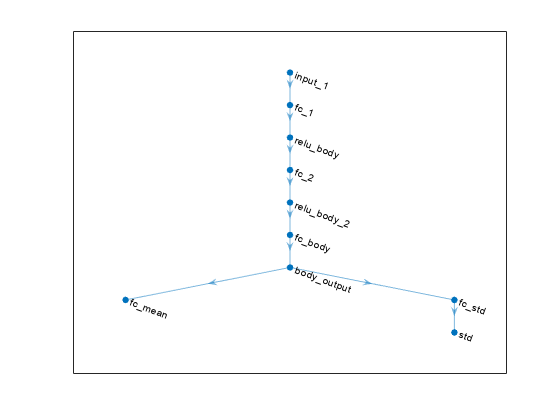setModel
Set approximation model in function approximator object
Description
newFcnAppx = setModel(fcnAppx,model)newFcnAppx, with the same
configuration as the original object, fcnAppx, but with the
approximation model specified in model.
Examples
Create an environment with a continuous action space and obtain its observation and action specifications. For this example, load the environment used in the example Compare DDPG Agent to LQR Controller.
Load the predefined environment.
env = rlPredefinedEnv("DoubleIntegrator-Continuous");Obtain observation and action specifications.
obsInfo = getObservationInfo(env); actInfo = getActionInfo(env);
Create a PPO agent from the environment observation and action specifications. This agent uses default deep neural networks for its actor and critic.
agent = rlPPOAgent(obsInfo,actInfo);
To modify the deep neural networks within a reinforcement learning agent, you must first extract the actor and critic function approximators.
actor = getActor(agent); critic = getCritic(agent);
Extract the deep neural networks from both the actor and critic function approximators.
actorNet = getModel(actor); criticNet = getModel(critic);
Plot the actor network.
plot(actorNet)

To validate a network, use analyzeNetwork. For example, validate the critic network.
analyzeNetwork(criticNet)
You can modify the actor and critic networks and save them back to the agent. To modify the networks, you can use the Deep Network Designer app. To open the app for each network, use the following commands.
deepNetworkDesigner(criticNet) deepNetworkDesigner(actorNet)
In Deep Network Designer, modify the networks. For example, you can add additional layers to your network. When you modify the networks, do not change the input and output layers of the networks returned by getModel. For more information on building networks, see Build Networks with Deep Network Designer.
To validate the modified network in Deep Network Designer, you must click on Analyze, under the Analysis section. To export the modified network structures to the MATLAB® workspace, generate code for creating the new networks and run this code from the command line. Do not use the exporting option in Deep Network Designer. For an example that shows how to generate and run code, see Create DQN Agent Using Deep Network Designer and Train Using Image Observations.
For this example, the code for creating the modified actor and critic networks is in the createModifiedNetworks helper script.
createModifiedNetworks
Each of the modified networks includes an additional fullyConnectedLayer and reluLayer in their main common path. Plot the modified actor network.
plot(modifiedActorNet)

After exporting the networks, insert the networks into the actor and critic function approximators.
actor = setModel(actor,modifiedActorNet); critic = setModel(critic,modifiedCriticNet);
Finally, insert the modified actor and critic function approximators into the actor and critic objects.
agent = setActor(agent,actor); agent = setCritic(agent,critic);
Input Arguments
Function approximator, specified as one of the following:
rlValueFunctionobject — Value function criticrlQValueFunctionobject — Q-value function criticrlVectorQValueFunctionobject — Multi-output Q-value function critic with a discrete action spacerlContinuousDeterministicActorobject — Deterministic policy actor with a continuous action spacerlDiscreteCategoricalActor— Stochastic policy actor with a discrete action spacerlContinuousGaussianActorobject — Stochastic policy actor with a continuous action spacerlContinuousDeterministicTransitionFunctionobject — Continuous deterministic transition function for a model-based agentrlContinuousGaussianTransitionFunctionobject — Continuous Gaussian transition function for a model-based agentrlContinuousDeterministicRewardFunctionobject — Continuous deterministic reward function for a model-based agentrlContinuousGaussianRewardFunctionobject — Continuous Gaussian reward function for a model-based agent.rlIsDoneFunctionobject — Is-done function for a model-based agent
To create an actor or critic function object, use one of the following methods.
Note
For agents with more than one critic, such as TD3 and SAC agents, you must call
getModel for each critic representation individually. You
cannot call getModel for the array returned by
getCritic.
critics = getCritic(myTD3Agent); criticNet1 = getModel(critics(1)); criticNet2 = getModel(critics(2));
Function approximation model, specified as one of the following:
Deep neural network defined as an array of
Layerobjects, alayerGraphobject, aDAGNetworkobject, or adlnetworkobject. The input and output layers ofmodelmust have the same names and dimensions as the network returned bygetModelfor the same function object. Here, the output layer is the layer immediately before the output loss layer.rlTableobject with the same dimensions as the table model defined innewRep.1-by-2 cell array that contains the function handle for a custom basis function and the basis function parameters.
When specifying a new model, you must use the same type of model as the one already
defined in newRep.
Note
For agents with more than one critic, such as TD3 and SAC agents, you must call
setModel for each critic representation individually, rather
than calling setModel for the array of returned by
getCritic.
critics = getCritic(myTD3Agent);
% Modify critic networks.
critics(1) = setModel(critics(1),criticNet1);
critics(2) = setModel(critics(2),criticNet2);
myTD3Agent = setCritic(myTD3Agent,critics);
Output Arguments
New function approximator, returned as an object of the same type as
oldFcnAppx. Except for its new function approximation model,
newFcnAppx is the same as oldFcnAppx.
Version History
Introduced in R2020bUsing representation objects to create actors and critics for reinforcement learning
agents is no longer recommended. Therefore, setModel now uses function
approximator objects instead.
See Also
Functions
getModel|getActor|setActor|getCritic|setCritic|getNormalizer|setNormalizer|getLearnableParameters|setLearnableParameters
Objects
dlnetwork|rlValueFunction|rlQValueFunction|rlVectorQValueFunction|rlContinuousDeterministicActor|rlDiscreteCategoricalActor|rlContinuousGaussianActor|rlContinuousDeterministicTransitionFunction|rlContinuousGaussianTransitionFunction|rlContinuousDeterministicRewardFunction|rlContinuousGaussianRewardFunction|rlIsDoneFunction
MATLAB Command
You clicked a link that corresponds to this MATLAB command:
Run the command by entering it in the MATLAB Command Window. Web browsers do not support MATLAB commands.
选择网站
选择网站以获取翻译的可用内容,以及查看当地活动和优惠。根据您的位置,我们建议您选择:。
您也可以从以下列表中选择网站:
如何获得最佳网站性能
选择中国网站(中文或英文)以获得最佳网站性能。其他 MathWorks 国家/地区网站并未针对您所在位置的访问进行优化。
美洲
- América Latina (Español)
- Canada (English)
- United States (English)
欧洲
- Belgium (English)
- Denmark (English)
- Deutschland (Deutsch)
- España (Español)
- Finland (English)
- France (Français)
- Ireland (English)
- Italia (Italiano)
- Luxembourg (English)
- Netherlands (English)
- Norway (English)
- Österreich (Deutsch)
- Portugal (English)
- Sweden (English)
- Switzerland
- United Kingdom (English)